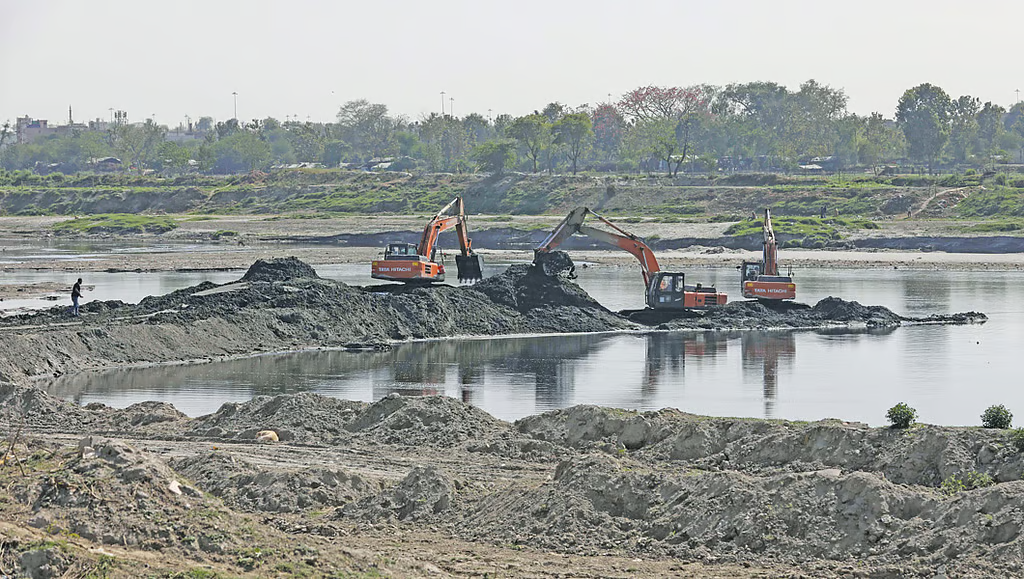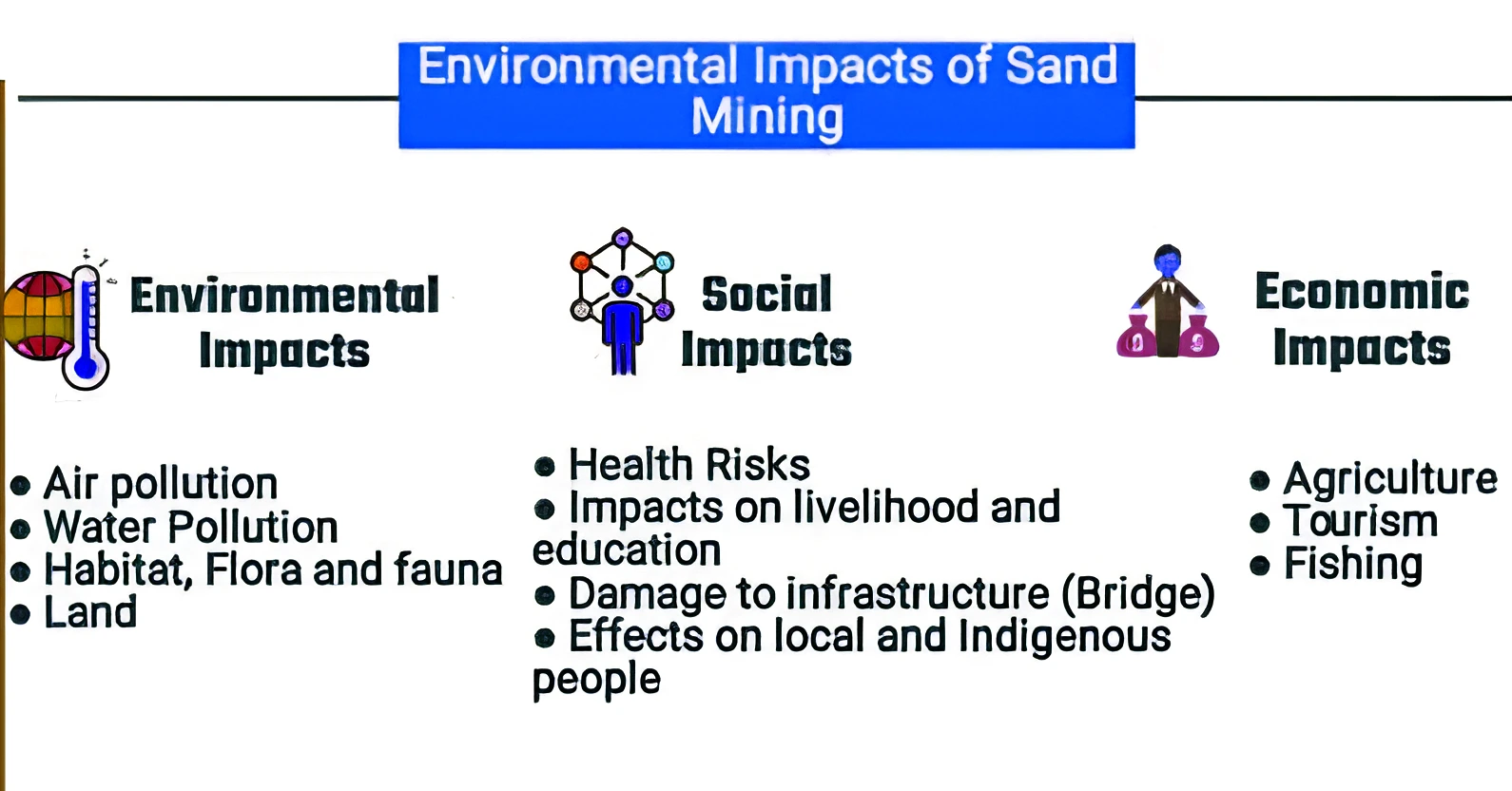



The 2025 Supreme Court ruling mandates replenishment studies for sustainable sand mining, reinforcing environmental law. Successful implementation depends on tech-driven enforcement against illegal extraction and developing the M-Sand market. This dual strategy is crucial to protect river ecosystems while meeting construction demands.

Copyright infringement not intended
Picture Courtesy: DOWNTOEARTH
The Supreme Court mandates that authorities conduct a sand replenishment study before approving any river Sand mining.
A scientific sand replenishment study need arises from the need to prevent over-extraction and mitigate the severe impacts of unscientific mining.
Reinforced by the Supreme Court, this mandate is rooted in the Sustainable Sand Mining Management Guidelines (SSMG-2016 and 2020) and the Environment Impact Assessment (EIA) Notification 2006.
The study calculates the ‘Annual Replenishment Rate’—the rate at which sand naturally deposits back into the river channel each year. The extraction limit must be less than or equal to this natural replenishment rate.
Sand mining is the process of extracting sand from various environments, including riverbeds, floodplains, and coastal areas.
While it is necessary for construction, illegal river sand mining—the unauthorized and unregulated extraction from river ecosystems—is the core of the problem.
Several factors contribute to the illegal sand mining in India:

Environmental & Hydrological Impacts
Groundwater Depletion: Sand beds are vital for filtering water and recharging aquifers. Their removal lowers the riverbed and inhibits the water-holding capacity, causing the groundwater table to drop.
Erosion and Flooding: Excessive extraction destabilizes stream channels, causes riverbank erosion, and alters flow patterns, which increase the severity of floods and damage downstream infrastructure.
Biodiversity Loss: Mining destroys the habitats of aquatic and riparian species, disrupting fish breeding and migration.
Economic and Regulatory Challenges
Revenue Loss: The vast disparity between high demand and limited legal supply fuels rampant illegal mining, resulting in a direct and significant loss of revenue to the State.
Development Conflict: Unregulated extraction poses a long-term threat to the very infrastructure it supports (e.g., destabilizing bridge foundations and embankments).
Livelihood Loss: The activity leads to agrarian distress and loss of livelihood for communities dependent on the river (fisheries, agriculture).
Regulatory Framework in India
Sand is classified as a "minor mineral" under the Mines and Minerals (Development and Regulations) Act, 1957, giving state governments the power to regulate it.
In Deepak Kumar v/s State of Haryana case (2012), the Supreme Court made Environmental Clearance (EC) mandatory for all mining of minor minerals, irrespective of the lease size.
Sustainable Sand Mining Management Guidelines (SSMG) introduced the requirement of a District Survey Report (DSR) as the basis for all mining approvals. The core purpose of the DSR is to scientifically assess the river's sand deposits.
The Supreme Court's order in August 2025, clarified that a DSR is legally invalid without a proper scientific replenishment study.
Resource Diversification (Sustainable Alternatives)
Promote Manufactured Sand: M-Sand, produced by crushing rocks or utilizing Construction and Demolition (C&D) waste, is a sustainable alternative.
Policy Intervention: States like Rajasthan are creating models by offering financial incentives for M-Sand units and mandating its use in government construction projects.
Tech-Based Enforcement and Monitoring
Mandatory Tracking: Implement full IT-enabled systems as required by Enforcement & Monitoring Guidelines for Sand Mining (EMGSM) 2020 , including GPS tracking on all transport vehicles, CCTV at mine sites, and secure, IT-enabled transit permits to prevent illegal trade.
Advanced Surveillance: Utilize Drones, AI and satellite monitoring (Mining Surveillance System) for regular surveillance, volume calculation, and checking for encroachment outside approved lease areas.
Strengthening Institutional and Social Accountability
Independent Audits: Mandate that replenishment studies and annual environmental audits are conducted by independent experts.
Community Participation: Empower local bodies and Gram Sabhas, making them stakeholders in monitoring, reporting illegal activities, annual audits, to ensure accountability and protects their livelihoods[
Strict Penalties: Enforce penalties that include not just fines, but confiscation of vehicles and legal action against the criminal nexus responsible for illegal mining.
The 2025 Supreme Court ruling requires scientific sand replenishment studies, demanding strict enforcement against illegal mining and promoting sustainable alternatives like M-Sand to safeguard rivers and ensure ecological balance.
Source: DOWNTOEARTH
|
PRACTICE QUESTION Q. How does sand mining compromise the ecological integrity of River ecosystems? 150 words |
A Mandatory Replenishment Assessment is a scientific study to determine the annual rate at which sand naturally replenishes in a river, ensuring extraction does not exceed this rate.
Sand mining extracts sand from riverbeds, floodplains, or coasts. While needed for construction, illegal and unscientific extraction causes environmental degradation, erosion, biodiversity loss, and groundwater depletion.
Manufactured Sand (M-Sand) from crushed rocks or Construction & Demolition waste can reduce pressure on rivers.




© 2025 iasgyan. All right reserved